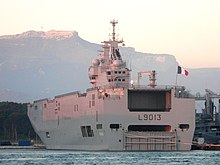HMAS Toowoomba returns to Fleet Base West in Rockingham, Western Australia after returning from deployment. Photo: CPOIS Yuri Ramsey.
The federal government has accused the People’s Republic of China of unsafe and unprofessional conduct after Royal Australian Navy divers were injured by a People’s Liberation Army-Navy destroyer in international waters.
The crew of Anzac Class frigate HMAS Toowoomba suffered minor injuries after being exposed to sonar pulses from hull-mounted sonar on the Chinese destroyer operating within international waters, inside of Japan’s Exclusive Economic Zone, on 14 November.
HMAS Toowoomba had been undertaking operations in support of United Nations-sanctioned enforcement when it stopped to begin diving operations in order to clear fishing nets that had become entangled around its propellers.
While diving operations were underway, a PLA-N destroyer (DDG-139) operating in the vicinity closed towards HMAS Toowoomba. HMAS Toowoomba communicated its intention to conduct diving operations on normal maritime channels and used internationally recognised signals. It advised the PLA-N destroyer that diving operations were being conducted and requested the ship keep clear.
The Chinese vessel approached at a closer range and was detected operating its hull-mounted sonar in an unsafe and unprofessional manner that posed a risk to the safety of the Australian divers who were forced to exit the water.
Medical assessments conducted after the divers exited the water identified they had sustained minor injuries likely due to being subjected to the sonar pulses from the Chinese destroyer.
Deputy Prime Minister and Minister for Defence Richard Marles said safety and wellbeing of Australian Defence Force personnel continues to be of the utmost priority.
“The Australian government has expressed its serious concerns to the Chinese government following an unsafe and unprofessional interaction with a People’s Liberation Army Navy destroyer,” he said.
“The interaction with HMAS Toowoomba occurred in international waters, inside of Japan’s Exclusive Economic Zone.
“The safety and wellbeing of our ADF personnel is our utmost priority.
“Australia expects all countries, including China, to operate their militaries in a professional and safe manner.
“Defence has for decades undertaken maritime surveillance activities in the region and does so in accordance with international law, exercising the right to freedom of navigation and overflight in international and airspace.”
Shadow Minister for Defence Andrew Hastie also condemned the actions of the People’s Liberation Army-Navy after the Royal Australian Navy divers on HMAS Toowoomba were injured in international waters.
“While the responsibility is solely on the Chinese PLA Navy, the Albanese government also has some serious questions to answer,” he said.
“Reports that the Prime Minister knew about this incident and deliberately withheld information until after leaving for the Asia-Pacific Economic Cooperation (APEC) summit are, if true, outrageous and unacceptable.
“The Prime Minister must explain why he chose to wait until after he left the country to disclose this information, and whether he raised it directly with President Xi Jinping at APEC.
“What we continue to see from the Prime Minister and his Labor government is a lack of leadership and a lack of action.
“In a week in which the government has failed its most basic task – to keeping Australians safe – the Albanese government has again proved that it can’t be trusted on national security.
“We have always said that we will judge the Chinese Communist Party on their actions rather than their words, and this provocative behaviour contradicts the government’s belief they are witnessing a stabilisation of the relationship with China. This incident is evidence to the contrary.
“The Prime Minister must immediately disclose whether he raised this matter with President Xi, or whether it was withheld for expedient political purposes. Any failure to do so would rightly raise questions around Anthony Albanese’s ability to lead our nation.”






















